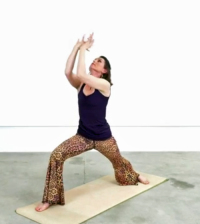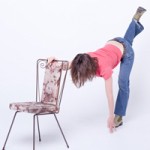by Kara-Leah Grant
Welcome to the third Creative Sun Salutation Abundance flow here on The Yoga Lunchbox.
This week we move into the heart of our abundance sun salutation, moving through variations of Warrior I pose.
Most of you will be familiar with Warrior I, yet no matter how many times you may have done it, there’s always something to learn.
Taking time and playing within each pose, separating out the components of it, is a masterful way to learn the posture from the inside out.
When you practice in this way, you don’t need to know anatomy. All you need do is train your awareness on your experience.
What happens in my hips when I move my foot this way? If I move this hip forward, what happens in my thoracic spine? If I do this with my pelvis, how does it affect my legs?
This is the heart of our yoga practice – tuning into our breath, bringing consciousness to our actions, and exploring while collecting data and collating results. Over time, this is how I’ve found ease in Warrior I, which has long been my nemesis, especially on the right side. It’s a difficult posture for the hips and spine to release into.
I’ve learned to find more ease by taking my time and sometimes spending ten minutes or more playing in aspects of Warrior I, adding movement as a way of freeing up holding tension in the posture.
What I didn’t know was that this intuitive movement which arose out of my breath and deep state of presence was exactly what my body needed on an anatomical level to release the iliopsoas muscle group, which I suspect was one of the main reasons why I struggled with this pose.
This is how yoga – bringing total presence to your actions on the mat – arises from within, and this is what I invite you to do today.
Use my video as inspiration for your own playing on the mat. Take your time exploring how you ground your back foot in the transition from high lunge to Warrior I legs and pay attention to how that movement of the foot affects your hips.
So often, when we’re moving an extremity – like a hand or a foot – that’s where our awareness goes and so that becomes the place we move from. Instead, see what happens if you keep your awareness on the roots of the movement and come from that place.
It’s not something I mention directly in the video – in the continuing evolution of my yoga practice, it’s something I’ve only been playing with in the last week or so. (Another reason why home yoga practice is so vital for teachers – this is where you learn what to teach!).
When you’re grounding that back foot on a 45 degree angle and setting up for Warrior I, see if you can move from inside your pelvis or inside your hip joint. What happens when you do? I notice an inclination to bend my back knee and then extend it straight. This seems to give me more space in that hip.
(I don’t know for sure, but I suspect it’s got something to do with the way the iliopsoas muscle group attaches to the lessor trochanter of the femur bone. I need to explore this further.)
In this way, playing with my practice and noticing how my body responds to certain movements provides clues for better understanding my body’s intricacies.
You may notice something completely different in your body which leads you to different understandings of how your body works and how it needs to move in order to free up and strength.
This is what makes what we’re doing yoga practice – we’re playing and exploring and seeing what happens according to the needs of our bodies.
Ditto once we come up and play with the pelvis in Warrior I. Inhaling and straightening the front leg while our feet are grounded for Warrior I turns on the inner leg muscles so there’s a sense of hugging the midline.
Exhaling as you release back down into the front bent leg allows the iliopsoas muscle group (which runs from the inner abdomen down through the lumbar and pelvis) to release and helps to orientate the pelvis back (posteriorly). This exhale strongly activates the muscles in the front leg as they turn on to provide support.
My intuition is that this conscious inhale and exhale leg action teaches the iliopsoas muscle group to let go – for some of us, it’s always trying to hold on hard, including in lunge-like positions where we want it to release. I’ve found using the breath and moving actively in and out of strong standing stances a powerful way to re-programme my muscles.
Finally, we bring the arms into the posture – after doing all the solid grounding work through the feet, the legs and the pelvis.
When you take this kind of time to explore your movement through breath and awareness, it can take half an hour to go through a short sequence, but the depth of learning can be extraordinary. This is home yoga practice – not just doing the poses to be done, but being in the poses to deepen your consciousness and presence.
Use my instruction as a diving off point, and go play!
Remember, this video is designed to be used after you’ve learned and integrated Week 1 & Week 2 into your practice.
After you add this segment to your sequence, you may wish to finish off the evolving sun salutation anyway that works for you. Make sure you do both sides!
Next week, we’ll add a fourth part, until at the end of our six weeks we have a complete Abundance Sun Salutation.
If you have any questions about the practice, please leave a comment.
If you’re reading this in an email, you won’t be able to see the video – you have to go to the website for that, and you need to be an Insider to access the full article with video.
Inside the Box only costs $NZ35/yr or $5/month, you can find out more & sign up here.
Exploring How to Release the Iliopsoas Muscle Group in Warrior I
Want to experience more Abundance on the Yoga Mat?
You can sign up for workshop I’m teaching in Napier, December 12 & 13 2014, The Bhavana Immersion.
We’re covering four feeling states, including abundance. Find out more here.
I’ll also be teaching an Abundance Flow at Wanderlust Great Lake Taupo January 29 – February 1, 2015. You can buy tickets here and see my teaching schedule here.
[Note: I’m a total beginner on all this anatomy stuff. I intuitively understand and can move and instruct according to the needs of the body, but I’m only just beginning to learn exactly what’s happening on an anatomical level. If I have made a mistake in how I’ve named or described anything, please let me know. Collective group mind rules!]


Leave a Reply